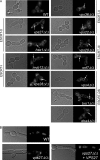The Candida albicans ESCRT pathway makes Rim101-dependent and -independent contributions to pathogenesis
- PMID: 20581294
- PMCID: PMC2918940
- DOI: 10.1128/EC.00056-10
The Candida albicans ESCRT pathway makes Rim101-dependent and -independent contributions to pathogenesis
Abstract
Candida albicans is an opportunistic pathogen that colonizes diverse mucosal niches with distinct environmental characteristics. To adapt to these different sites, C. albicans must activate and attenuate a variety of signal transduction pathways. A mechanism of signal attenuation is through receptor endocytosis and subsequent vacuolar degradation, which requires the endosomal sorting complex required for transport (ESCRT) pathway. This pathway comprises several polyprotein complexes (ESCRT-0, -I, -II, -III, and -DS) that are sequentially recruited to the endosomal membrane. The ESCRT pathway also activates the Rim101 transcription factor, which governs expression of genes required for virulence. Here, we tested the hypothesis that the ESCRT pathway plays a Rim101-independent role(s) in pathogenesis. We generated deletion mutants in each ESCRT complex and determined that ESCRT-I, -II, and -III are required for Rim101 activation but that ESCRT-0 and ESCRT-DS are not. We found that the ESCRT-0 member Vps27 and ESCRT-DS components are required to promote epithelial cell damage and, using a murine model of oral candidiasis, found that the vps27Delta/Delta mutant had a decreased fungal burden compared to that of the wild type. We found that a high-dose inoculum can compensate for fungal burden defects but that mice colonized with the vps27Delta/Delta strain exhibit less morbidity than do mice infected with the wild-type strain. These results demonstrate that the ESCRT pathway has Rim101-independent functions for C. albicans virulence.
Figures









Similar articles
-
Snf7p, a component of the ESCRT-III protein complex, is an upstream member of the RIM101 pathway in Candida albicans.Eukaryot Cell. 2004 Dec;3(6):1609-18. doi: 10.1128/EC.3.6.1609-1618.2004. Eukaryot Cell. 2004. PMID: 15590834 Free PMC article.
-
Mutational analysis of Candida albicans SNF7 reveals genetically separable Rim101 and ESCRT functions and demonstrates divergence in bro1-domain protein interactions.Genetics. 2010 Mar;184(3):673-94. doi: 10.1534/genetics.109.112029. Epub 2009 Dec 21. Genetics. 2010. PMID: 20026677 Free PMC article.
-
Deletions of endocytic components VPS28 and VPS32 affect growth at alkaline pH and virulence through both RIM101-dependent and RIM101-independent pathways in Candida albicans.Infect Immun. 2005 Dec;73(12):7977-87. doi: 10.1128/IAI.73.12.7977-7987.2005. Infect Immun. 2005. PMID: 16299290 Free PMC article.
-
Adaptation to environmental pH in Candida albicans and its relation to pathogenesis.Curr Genet. 2003 Oct;44(1):1-7. doi: 10.1007/s00294-003-0415-2. Epub 2003 Jun 18. Curr Genet. 2003. PMID: 12819929 Review.
-
How human pathogenic fungi sense and adapt to pH: the link to virulence.Curr Opin Microbiol. 2009 Aug;12(4):365-70. doi: 10.1016/j.mib.2009.05.006. Epub 2009 Jul 23. Curr Opin Microbiol. 2009. PMID: 19632143 Review.
Cited by
-
The β-arrestin-like protein Rim8 is hyperphosphorylated and complexes with Rim21 and Rim101 to promote adaptation to neutral-alkaline pH.Eukaryot Cell. 2012 May;11(5):683-93. doi: 10.1128/EC.05211-11. Epub 2012 Mar 16. Eukaryot Cell. 2012. PMID: 22427429 Free PMC article.
-
A P4-ATPase subunit of the Cdc50 family plays a role in iron acquisition and virulence in Cryptococcus neoformans.Cell Microbiol. 2017 Jun;19(6):10.1111/cmi.12718. doi: 10.1111/cmi.12718. Epub 2017 Jan 23. Cell Microbiol. 2017. PMID: 28061020 Free PMC article.
-
Cryptococcal titan cell formation is regulated by G-protein signaling in response to multiple stimuli.Eukaryot Cell. 2011 Oct;10(10):1306-16. doi: 10.1128/EC.05179-11. Epub 2011 Aug 5. Eukaryot Cell. 2011. PMID: 21821718 Free PMC article.
-
Mathematical modeling of the Candida albicans yeast to hyphal transition reveals novel control strategies.PLoS Comput Biol. 2021 Mar 29;17(3):e1008690. doi: 10.1371/journal.pcbi.1008690. eCollection 2021 Mar. PLoS Comput Biol. 2021. PMID: 33780439 Free PMC article.
-
Pitavastatin Calcium Confers Fungicidal Properties to Fluconazole by Inhibiting Ubiquinone Biosynthesis and Generating Reactive Oxygen Species.Antioxidants (Basel). 2024 May 29;13(6):667. doi: 10.3390/antiox13060667. Antioxidants (Basel). 2024. PMID: 38929106 Free PMC article.
References
-
- Adams A., Gottschling D. E., Kaiser C. A., Stearns T. 1997. Methods in yeast genetics, 1997: a Cold Spring Harbor Laboratory course manual. Cold Spring Harbor Laboratory Press, Cold Spring Harbor, NY
-
- Babst M., Katzmann D. J., Estepa-Sabal E. J., Meerloo T., Emr S. D. 2002. Escrt-III: an endosome-associated heterooligomeric protein complex required for mvb sorting. Dev. Cell 3:271–282 - PubMed
-
- Babst M., Katzmann D. J., Snyder W. B., Wendland B., Emr S. D. 2002. Endosome-associated complex, ESCRT-II, recruits transport machinery for protein sorting at the multivesicular body. Dev. Cell 3:283–289 - PubMed
Publication types
MeSH terms
Substances
Grants and funding
LinkOut - more resources
Full Text Sources
Molecular Biology Databases

